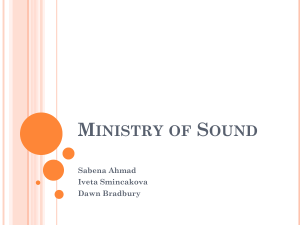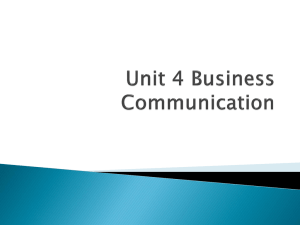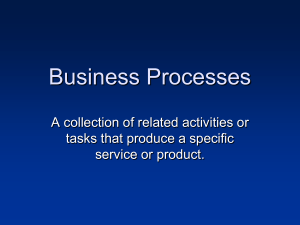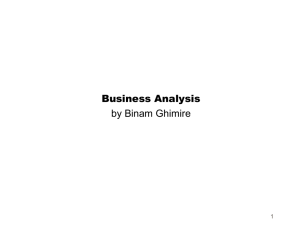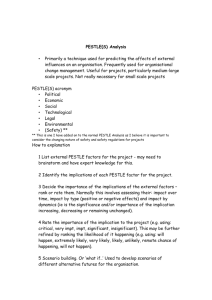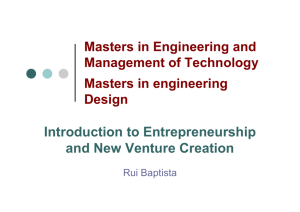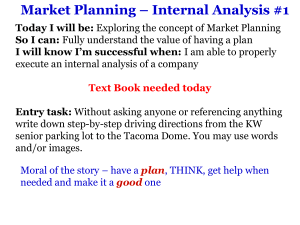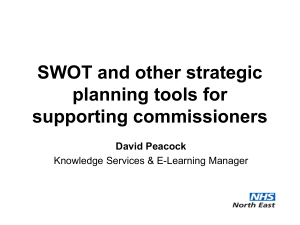Strategic Management 5e. (Hill & Jones)
advertisement
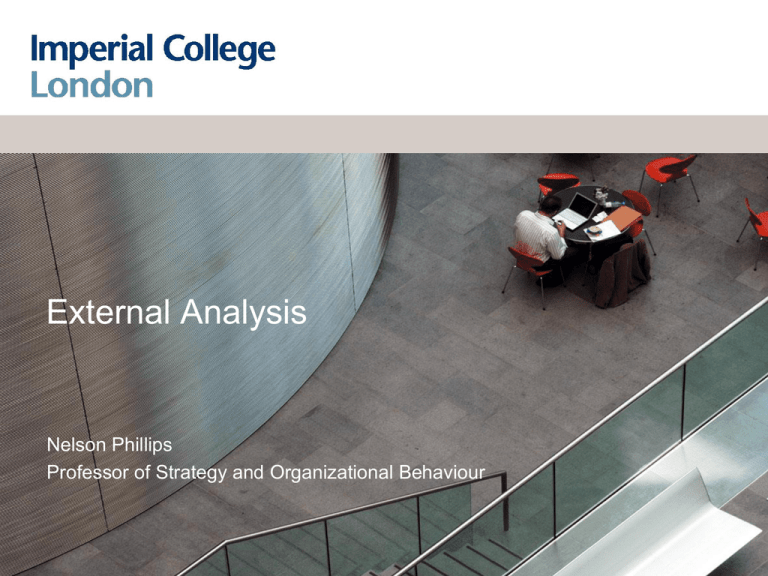
External Analysis Nelson Phillips Professor of Strategy and Organizational Behaviour Why are some industries more profitable than others over long periods of time? The Objectives of Industry Analysis • To understand how industry structure drives competition, which determines the level of industry profitability. • To assess industry attractiveness • To use evidence on changes in industry structure to forecast future profitability • To formulate strategies to change industry structure to improve industry profitability • To identify Key Success Factors From Environmental Analysis to Industry Analysis The national/ international economy The natural environment THE INDUSTRY ENVIRONMENT Technology Government & Politics • Suppliers • Competitors • Customers Demographic structure Social Social structure structure •The Industry Environment lies at the core of the Macro Environment. •The Macro Environment impacts the firm through its effect on the Industry Environment. The Determinants of Industry Profitability • 3 key influences: 1. The value of the product to customers 2. The intensity of competition 3. Relative bargaining power at different levels within the value chain. Porter’s Five Forces of Competition Framework SUPPLIERS Bargaining power of suppliers INDUSTRY COMPETITORS Threat of POTENTIAL ENTRANTS Threat of SUBSTITUTES new entrants Rivalry among existing firms substitutes Bargaining power of buyers BUYERS The Threat of Substitutes Extent of competitive pressure from producers of substitutes depends upon: • Buyers’ propensity to substitute • The price-performance characteristics of substitutes. The Threat of Entry • Entrants’ threat to industry profitability depends upon the height of barriers to entry. The principal sources of barriers to entry are: • Capital requirements • Economies of scale • Absolute cost advantage • Product differentiation • Access to channels of distribution • Legal and regulatory barriers • Retaliation Bargaining Power of Buyers Buyer’s price sensitivity • Cost of purchases as % of buyer’s total costs. • How differentiated is the purchased item? • How intense is competition between buyers? • How important is the item to quality of the buyers’ own output? Relative bargaining power • Size and concentration of buyers relative to sellers. • Buyer’s information . • Ability to backward integrate. Note: analysis of supplier power is symmetric Rivalry Between Established Competitors • The extent to which industry profitability is depressed by aggressive price competition depends upon: • Concentration (number and size distribution of firms) • Diversity of competitors (differences in goals, cost structure, etc.) • Product differentiation • Excess capacity and exit barriers • Cost conditions – Extent of scale economies – Ratio of fixed to variable costs The Structural Determinants of Competition BUYER POWER • Buyers’ price sensitivity • Relative bargaining power THREAT OF ENTRY •Capital requirements •Economies of scale •Absolute cost advantage •Product differentiation •Access to distribution channels •Legal/ regulatory barriers •Retaliation INDUSTRY RIVALRY •Concentration •Diversity of competitors •Product differentiation •Excess capacity & exit barriers •Cost conditions BUYER POWER • Buyers’ price sensitivity • Relative bargaining power SUBSTITUTE COMPETITION • Buyers’ propensity to substitute • Relative prices & performance of substitutes SWOT Exercise Work in groups from the same business area within Veolia, analyse the industry conditions facing that business. Make sure to write down your thoughts. PESTLE analysis • PESTLE is an analytical tool which considers external factors and helps you to think about their impacts PESTLE Analysis • Is a useful tool for understanding the “big picture” of the environment in which you are operating • By understanding your environment, you can take advantage of the opportunities and minimize the threats. • This provides the context within which more detailed planning can take place to take full advantage of the opportunities that present themselves. The factors in PESTLE analysis • P – Political – The current and potential influences from political pressures • E - Economic – The local, national and world economic impact • S - Sociological – The ways in which changes in society affect the project • T - Technological – How new and emerging technology affects our project / organization • L - Legal – How local, national and global legislation affects the project • E - Environmental – Local, national and global environmental issues PESTLE • Political: – – – – – – – Government type and stability Freedom of the press, rule of law and levels of bureaucracy and corruption Regulation and de-regulation trends Social and employment legislation Tax policy, and trade and tariff controls Environmental and consumer-protection legislation Likely changes in the political environment • Economic: – – – – – – – – Stage of a business cycle Current and projected economic growth, inflation and interest rates Unemployment and supply of labor Labor costs Levels of disposable income and income distribution Impact of globalization Likely impact of technological or other changes on the economy Likely changes in the economic environment PESTLE • Sociological: – – – – – Cultural aspects, health consciousness, population growth rate, age distribution, Organizational culture, attitudes to work, management style, staff attitudes Education, occupations, earning capacity, living standards Ethical issues, diversity, immigration/emigration, ethnic/religious factors Media views, law changes affecting social factors, trends, advertisements, publicity – Demographics: age, gender, race, family size • Technological: – Maturity of technology, competing technological developments, research funding, technology legislation, new discoveries – Information technology, internet, global and local communications – Technology access, licensing, patents, potential innovation, replacement technology/solutions, inventions, research, intellectual property issues, advances in manufacturing – Transportation, energy uses/sources/fuels, associated/dependent technologies, rates of obsolescence, waste removal/recycling PESTLE • Legal: – – – – – current home market legislation, future legislation European/international legislation regulatory bodies and processes environmental regulations, employment law, consumer protection industry-specific regulations, competitive regulations • Environmental: – – – – Ecological environmental issues, environmental regulations customer values, market values, stakeholder/ investor values management style, staff attitudes, organizational culture, staff engagement SWOT Exercise Work in groups from the same business area within Veolia perform a PESTLE for that business. Make sure to write down your thoughts. What is SWOT Analysis? A technique that enables a group or individual to move from everyday problems and traditional strategies to a fresh perspective. SWOT is an acronym for: S – Strengths Internal Environment W – Weaknesses O – Opportunities External Environment T – Threats Strength Any existing or potential resources or capability within the organisation that provides a competitive advantage in the market. Example: • Strong distribution network • Intense Staff commitment and loyalty • Strong support from funders Weakness Any existing or potential force which could serve as a barrier to maintaining or achieving a competitive advantage in the market. Example: • Lack of a clear organizational strategy • Lack of training opportunities for using a new software Opportunity Any existing or potential force in the external environment that, if properly leveraged, could provide a competitive advantage. Example: • Organisation’s geographic location • New technology Threat Any existing or potential force in the external environment that could erode a competitive advantage. Example: • A new entrant • A recession, rising interest rates, or tight credit lines Aim of SWOT Analysis 1. Take advantage of strengths and opportunities. 2. Minimise weaknesses and eliminate threats How to do SWOT Analysis? Step 1 Analyse Internal & External Environment Step 2 Perform SWOT Analysis Step 3 Prepare Action Plans A SWOT analysis is useful only when action plans and strategies are developed from the results SWOT Exercise Work in groups from the same business area within Veolia. 1. Combine the industry analysis you performed earlier with the results of your PESTLE and construct a SWOT diagram for your business 2. Be prepared to present back to the group
